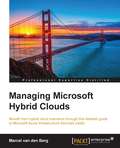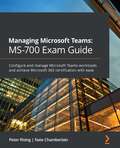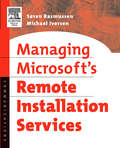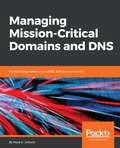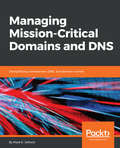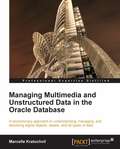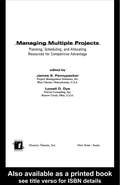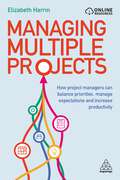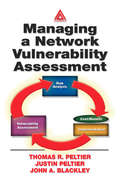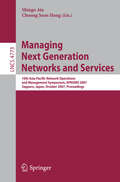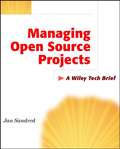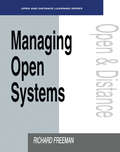- Table View
- List View
Managing Market Complexity: The Approach of Artificial Economics (Lecture Notes in Economics and Mathematical Systems #662)
by Andrea Teglio Simone Alfarano Eva Camacho-Cuena Miguel Ginés-VilarThe field of artificial economics (AE) embraces a broad range of methodologies relying on computer simulations in order to model and study the complexity of economic and social phenomena. The overarching principle of AE is the analysis of aggregate properties of artificial economies populated by adaptive agents that are equipped with behavioural rules and specific individual targets. These aggregate properties are neither foreseen nor intended by the artificial agents; conversely they are emerging characteristics of such artificially simulated systems. The book presents a peer-reviewed collection of papers addressing a variety of issues related to macroeconomics, industrial organization, networks, management and finance, as well as purely methodological issues.
Managing Microsoft Hybrid Clouds
by Marcel Van DenBergIf you're an IT professional, manager, consultant, or architect who wants to learn about hybrid cloud computing using Azure, then this is the book for you.
Managing Microsoft Teams: Configure and manage Microsoft Teams workloads and achieve Microsoft 365 certification with ease
by Nate Chamberlain Peter RisingDiscover how to plan a Microsoft Teams deployment within a business environment and manage Teams administrative functions on a day-to-day basisKey FeaturesPlan and design your Microsoft Teams deploymentPrepare, deploy, and manage policies for Microsoft Teams and for apps within TeamsPass the MS-700 exam and achieve certification with the help of self-assessment questions and a mock examBook DescriptionDo you want to build and test your proficiency in the deployment, management, and monitoring of Microsoft Teams features within the Microsoft 365 platform? Managing Microsoft Teams: MS-700 Exam Guide will help you to effectively plan and implement Microsoft Teams using the Microsoft 365 Teams admin center and Windows PowerShell. You'll also discover best practices for rolling out and managing MS services for Teams users within your Microsoft 365 tenant. The chapters are divided into three easy-to-follow parts: planning and design, feature policies and administration, and team management, while aligning with the official MS-700 exam objectives to help you prepare effectively for the exam. The book starts by taking you through planning and design, where you'll learn how to plan migrations, make assessments for network readiness, and plan and implement governance tasks such as configuring guest access and monitoring usage. Later, you'll understand feature administration, focusing on collaboration, meetings, live events, phone numbers, and the phone system, along with applicable policy configurations. Finally, the book shows you how to manage Teams and membership settings and create app policies. By the end of this book, you'll have learned everything you need to pass the MS-700 certification exam and have a handy reference guide for MS Teams.What you will learnExplore Security & Compliance configuration options for Teams featuresManage meetings, calls, and chat features within Microsoft TeamsFind out how to manage phone numbers, systems, and settings in TeamsManage individual team settings, membership, and guest accessCreate policies for Microsoft Teams apps and featuresDeploy access reviews and dynamic team membershipWho this book is forThis Microsoft Teams book is for IT professionals who want to achieve Microsoft 365 Certified: Teams Administrator Associate certification. Familiarity with the principles of establishing and administering the core features and services within a Microsoft 365 tenant and a basic understanding of Microsoft Teams features are required before getting started with the book. Prior knowledge of other Microsoft 365 workloads such as Security & Compliance will also be beneficial.
Managing Microsoft's Remote Installation Services
by Soren Rasmussen Michael IversenBRIEF DESCRIPTION OF CONTENT: The authors have been working with Remote Installation Services since its birth in 1999. We are really enthusiastic about working with it. From their experiences from very different customers with very different requirements to their Windows infrastructure environment, they have gained a tremendous deal of experience and in-depth knowledge with Remote Installation Services that other people can benefit from. This includes basic understanding, a lot of theory and best-practices, but also how you can stretch Remote Installation Services to really do what any system or network administrator would require. This information is essential for anyone wishing to implement Remote Installation Services and use the advanced features and tools it contains. There is much more than up grades, adding and deleting programs from a central administrator that can be done In addition it can save the cost adding a costly third party software package like Alteris to the enterprise network. This is the reason that the authors are now gathering all the experience and knowledge, and focusing on forming a single point of entry to everything you must know about Remote Installation Services in form of a book. Note based on my (TRS) and reviewers comments the book will be over 320 pages as authors ad numerous consulting client examples and illustrations UNIQUE FEATURE: Book is excellent companion to Windows and Exchange series and WMI books by Lissoir: Authors are top quality IBM Consultants· Gives Network and Systems Administrators real tools to manage up grades, program modifications and system and security related tools · Presents a balance of theory and methods with best-practices the authors have developed in their consulting work· Shows how an enterprise can save the cost adding a costly third party software package like Alteris to the enterprise network
Managing Mission Critical Domains and DNS: Demystifying Nameservers, Dns, And Domain Names
by Mark JeftovicManaging your organization's naming architecture and mitigating risks within complex naming environments is very important. This book will start with the basic anatomies of domain name servers and the request mechanism of DNS servers. You will also cover different factors associated with DNS servers such as security, strategy, and DNS queries.
Managing Mission - Critical Domains and DNS: Demystifying nameservers, DNS, and domain names
by Mark E. JeftovicThis book will give you an all encompassing view of the domain name ecosystem combined with a comprehensive set of operations strategies. About This BookManage infrastructure, risk, and management of DNS name servers. Get hands-on with factors like types of name servers, DNS queries and and so on.Practical guide for system administrators to manage mission-critical serversBased on real-world experience - Written by an industry veteran who has made every possible mistake within this field.Who This Book Is ForIdeal for sysadmins, webmasters, IT consultants, and developers-anyone responsible for maintaining your organization's core DNSWhat You Will LearnAnatomy of a domain - how a domain is the sum of both its DNS zone and its registration data, and why that matters.The domain name ecosystem - the role of registries, registrars and oversight bodies and their effect on your names.How DNS queries work - queries and responses are examined including debugging techniques to zero in on problems.Nameserver considerations - alternative nameserver daemons, numbering considerations, and deployment architectures.DNS use cases - the right way for basic operations such as domain transfers, large scale migrations, GeoDNS, Anycast DNS.Securing your domains - All aspects of security from registrar vendor selection, to DNSSEC and DDOS mitigation strategies.In DetailManaging your organization's naming architecture and mitigating risks within complex naming environments is very important. This book will go beyond looking at “how to run a name server” or “how to DNSSEC sign a domain”, Managing Mission Critical Domains & DNS looks across the entire spectrum of naming; from external factors that exert influence on your domains to all the internal factors to consider when operating your DNS. The readers are taken on a comprehensive guided tour through the world of naming: from understanding the role of registrars and how they interact with registries, to what exactly is it that ICANN does anyway? Once the prerequisite knowledge of the domain name ecosystem is acquired, the readers are taken through all aspects of DNS operations. Whether your organization operates its own nameservers or utilizes an outsourced vendor, or both, we examine the complex web of interlocking factors that must be taken into account but are too frequently overlooked. By the end of this book, our readers will have an end to end to understanding of all the aspects covered in DNS name servers.Style and approachThe book is divided into two parts, the first part looks at the wider domain name ecosystem: registries, registrars and oversight policies.The second and larger part goes into operations. Every aspect of naming is considered from the viewpoint of how this affects ones domains, what are the ramifications of different operating methods as portfolios scale.
Managing Mission - Critical Domains and DNS: Demystifying nameservers, DNS, and domain names
by Mark E. JeftovicThis book will give you an all encompassing view of the domain name ecosystem combined with a comprehensive set of operations strategies. About This BookManage infrastructure, risk, and management of DNS name servers. Get hands-on with factors like types of name servers, DNS queries and and so on.Practical guide for system administrators to manage mission-critical serversBased on real-world experience - Written by an industry veteran who has made every possible mistake within this field.Who This Book Is ForIdeal for sysadmins, webmasters, IT consultants, and developers-anyone responsible for maintaining your organization's core DNSWhat You Will LearnAnatomy of a domain - how a domain is the sum of both its DNS zone and its registration data, and why that matters.The domain name ecosystem - the role of registries, registrars and oversight bodies and their effect on your names.How DNS queries work - queries and responses are examined including debugging techniques to zero in on problems.Nameserver considerations - alternative nameserver daemons, numbering considerations, and deployment architectures.DNS use cases - the right way for basic operations such as domain transfers, large scale migrations, GeoDNS, Anycast DNS.Securing your domains - All aspects of security from registrar vendor selection, to DNSSEC and DDOS mitigation strategies.In DetailManaging your organization's naming architecture and mitigating risks within complex naming environments is very important. This book will go beyond looking at “how to run a name server” or “how to DNSSEC sign a domain”, Managing Mission Critical Domains & DNS looks across the entire spectrum of naming; from external factors that exert influence on your domains to all the internal factors to consider when operating your DNS. The readers are taken on a comprehensive guided tour through the world of naming: from understanding the role of registrars and how they interact with registries, to what exactly is it that ICANN does anyway? Once the prerequisite knowledge of the domain name ecosystem is acquired, the readers are taken through all aspects of DNS operations. Whether your organization operates its own nameservers or utilizes an outsourced vendor, or both, we examine the complex web of interlocking factors that must be taken into account but are too frequently overlooked. By the end of this book, our readers will have an end to end to understanding of all the aspects covered in DNS name servers.Style and approachThe book is divided into two parts, the first part looks at the wider domain name ecosystem: registries, registrars and oversight policies.The second and larger part goes into operations. Every aspect of naming is considered from the viewpoint of how this affects ones domains, what are the ramifications of different operating methods as portfolios scale.
Managing Multimedia and Unstructured Data in the Oracle Database
by Marcelle KratochvilThis book is written in simple, easy to understand format with lots of screenshots and step-by-step explanations. If you are an Oracle database administrator, Museum curator, IT manager, Developer, Photographer, Intelligence team member, Warehouse or Software Architect then this book is for you. It covers the basics and then moves to advanced concepts. This will challenge and increase your knowledge enabling all those who read it to gain a greater understanding of multimedia and how all unstructured data is managed.
Managing Multiple Projects: Planning, Scheduling, and Allocating Resources for Competitive Advantage
by Lowell Dye"Details time-efficient and cost-effective strategies to evaluate, select, prioritize, plan, and manage multiple projects. Presents proven methods and practical applications for the development of successful project portfolios and prosperous multiproject environments. Provides useful models and scheduling frameworks for increasecd quality and produ
Managing Multiple Projects: How Project Managers Can Balance Priorities, Manage Expectations and Increase Productivity
by Elizabeth HarrinProject management is changing. Rather than focusing solely on one large project, the majority of project managers are now expected to juggle multiple projects, which brings a different set of challenges. Between a greater number of project sponsors, resource conflicts and constant pressure from deadlines, it can be difficult to avoid burnout. Managing Multiple Projects blends formal project management techniques with time management and productivity tools in a step-by-step approach to consolidating your workload. From combining schedules to prioritising work and engaging stakeholders, this book clearly explains how to adapt your behaviour and techniques to successfully work on several projects at once.This practical guide provides answers to commonly asked questions (such as how to reduce the number of meetings and how to manage a To Do list) and includes case studies from real project managers. Checklists for common tasks and adaptable templates of trackers and reports are combined with easily actioned exercises to improve processes. Managing Multiple Projects gives practitioners the tools they need to improve the chances of project success and maintain a work-life balance. Online resources include downloadable templates of productivity checklists and status reports.
Managing Multiple Projects: How Project Managers Can Balance Priorities, Manage Expectations and Increase Productivity
by Elizabeth HarrinProject management is changing. Rather than focusing solely on one large project, the majority of project managers are now expected to juggle multiple projects, which brings a different set of challenges. Between a greater number of project sponsors, resource conflicts and constant pressure from deadlines, it can be difficult to avoid burnout. Managing Multiple Projects blends formal project management techniques with time management and productivity tools in a step-by-step approach to consolidating your workload. From combining schedules to prioritising work and engaging stakeholders, this book clearly explains how to adapt your behaviour and techniques to successfully work on several projects at once.This practical guide provides answers to commonly asked questions (such as how to reduce the number of meetings and how to manage a To Do list) and includes case studies from real project managers. Checklists for common tasks and adaptable templates of trackers and reports are combined with easily actioned exercises to improve processes. Managing Multiple Projects gives practitioners the tools they need to improve the chances of project success and maintain a work-life balance. Online resources include downloadable templates of productivity checklists and status reports.
Managing A Nation: The Microcomputer Software Catalog--second Edition
by Gerald O. BarneyThis book is a collection of reviews of microcomputer programs of special relevance to those people around the world who are responsible for the management of the current and future affairs and business of their countries.
Managing A Nation: The Microcomputer Software Catalog--second Edition
by Gerald O. Barney W. Brian Kreutzer Martha J. Garrett Stephen J. Binhak Margee M. Ensign Richard Harwood David Holland Jennie M. Hommel J. G. Krishnayya Lynn A. Kurtz Kenneth L. Kvamme James W. Mercer Norman Meyers Peter J. Opdahl Ann Elise Schneider John D. Sterman Alan M. Thorndike Daniel Tunstall Sheryl WilkinsThis book is a collection of reviews of microcomputer programs of special relevance to those people around the world who are responsible for the management of the current and future affairs and business of their countries.
Managing Natural Resource Conflicts with Participatory Mapping and PGIS Applications
by Peter A. KyemThis book integrates spatial analysis into the study and management of conflicts, and offers a model in conflict studies that incorporates theoretical explanations of conflict, its causes, and impacts, with a geospatial strategy for intervening in disputes over allocation and use of natural resources (connects theory and practice). Alongside a theoretical analysis of resource conflicts and an account of Participatory Mapping and PGIS development, this book provides a case study of GIS applications in conflict mediation. The book also lays out a practical and straightforward demonstration of PGIS applications in conflict management using a real-world case study, and traces the Participatory Mapping and PGIS movements’ evolution, compares PPGIS and PGIS practices, and makes distinctions between traditional GIS applications and PGIS practice. The approach embodies the enhanced use of spatial information and media, sets of tools for analyzing, mapping, and displaying spatial data and a platform for participatory discussions that enhances consensus-building. The book, therefore, contributes to the search for novel approaches for managing current and emerging conflicts. With this book, resource managers, development practitioners, students, and scholars of Participatory Mapping and PGIS applications and conflict studies will be equipped with the principles, skills, and the tools they need to manage non-violent resource conflicts and keep the disputes from slipping into violence. The book will also be a valuable text for basic and advanced studies in Participatory Mapping and PGIS applications, Conflict Resolution and Conflict Management.
Managing A Network Vulnerability Assessment
by Thomas R. Peltier Justin Peltier John A. BlackleyThe instant access that hackers have to the latest tools and techniques demands that companies become more aggressive in defending the security of their networks. Conducting a network vulnerability assessment, a self-induced hack attack, identifies the network components and faults in policies, and procedures that expose a company to the damage caused by malicious network intruders. Managing a Network Vulnerability Assessment provides a formal framework for finding and eliminating network security threats, ensuring that no vulnerabilities are overlooked. This thorough overview focuses on the steps necessary to successfully manage an assessment, including the development of a scope statement, the understanding and proper use of assessment methodology, the creation of an expert assessment team, and the production of a valuable response report. The book also details what commercial, freeware, and shareware tools are available, how they work, and how to use them. By following the procedures outlined in this guide, a company can pinpoint what individual parts of their network need to be hardened, and avoid expensive and unnecessary purchases.
Managing Next Generation Networks and Services: 10th Asia-Pacific Network Operations and Management Symposium, APNOMS 2007, Sapporo, Japan, October 10-12, 2007, Proceedings (Lecture Notes in Computer Science #4773)
by Shingo Ata Choong Seon HongThis book constitutes the refereed proceedings of the 9th Asia-Pacific Network Operations and Management Symposium, APNOMS 2007, held in Sapporo, Japan, October 2007. The 48 revised full papers and 30 revised short papers cover management of distributed networks, network configuration and planning, network security management, sensor and ad-hoc networks, network monitoring, routing and traffic engineering, management of wireless networks and security on wireless networks.
Managing Online Instructor Workload: Strategies for Finding Balance and Success (Jossey-Bass Guides to Online Teaching and Learning #33)
by Simone C.O. Conceição Rosemary M. LehmanManaging Online Instructor Workload is a groundbreaking book that offers strategies, advice, illustrative examples, and a four-step process for identifying challenges and rethinking, prioritizing, managing, and balancing one's online instruction workload. Based on surveys and interviews with successful online instructors, the book is filled with timely and comprehensive insight that is essential for online instructors, instructional designers, faculty developers, and anyone who wants to succeed in online learning. Praise for Managing Online Instructor Workload "Managing Online Instructor Workload breaks the pattern of prior distance learning books with its research-based orientation by including a broad range of experience. This is a valuable resource to encourage greater faculty persistence and adoption."—Kathleen P. King, professor of higher education, University of South Florida, Tampa "This is a must-read for all online instructors who strive not only to provide a high-quality learning experience for their students but also maintain a quality life of their own!"—Rita-Marie Conrad, online educator and author "Do you teach online? Do you need sleep? Here is the first book that I know of that will allow you to do both?no more endless hours wasted online attempting to be an effective instructor."—Curtis J. Bonk, professor, Indiana University
Managing Online Instructor Workload: Strategies for Finding Balance and Success (Jossey-Bass Guides to Online Teaching and Learning #33)
by Simone C.O. Conceição Rosemary M. LehmanManaging Online Instructor Workload is a groundbreaking book that offers strategies, advice, illustrative examples, and a four-step process for identifying challenges and rethinking, prioritizing, managing, and balancing one's online instruction workload. Based on surveys and interviews with successful online instructors, the book is filled with timely and comprehensive insight that is essential for online instructors, instructional designers, faculty developers, and anyone who wants to succeed in online learning. Praise for Managing Online Instructor Workload "Managing Online Instructor Workload breaks the pattern of prior distance learning books with its research-based orientation by including a broad range of experience. This is a valuable resource to encourage greater faculty persistence and adoption."—Kathleen P. King, professor of higher education, University of South Florida, Tampa "This is a must-read for all online instructors who strive not only to provide a high-quality learning experience for their students but also maintain a quality life of their own!"—Rita-Marie Conrad, online educator and author "Do you teach online? Do you need sleep? Here is the first book that I know of that will allow you to do both?no more endless hours wasted online attempting to be an effective instructor."—Curtis J. Bonk, professor, Indiana University
Managing Online Learning: The Life-Cycle of Successful Programs
by John VivoloManaging Online Learning is a comprehensive guide to planning and executing effective online learning programs. Featuring contributions from experienced professionals across operations in university and corporate settings, this all-in-one resource provides leaders and administrators with informed strategies for supporting learners’ and instructors’ evolving needs, implementing and evaluating pedagogically sound technologies, projecting revenue-generating models, and anticipating future scaling challenges. These highly applied chapters cover essential topics such as unit design, management of staff and finances, student engagement, user experience and interface, data analytics, and more.
Managing Online Learning: The Life-Cycle of Successful Programs
by John VivoloManaging Online Learning is a comprehensive guide to planning and executing effective online learning programs. Featuring contributions from experienced professionals across operations in university and corporate settings, this all-in-one resource provides leaders and administrators with informed strategies for supporting learners’ and instructors’ evolving needs, implementing and evaluating pedagogically sound technologies, projecting revenue-generating models, and anticipating future scaling challenges. These highly applied chapters cover essential topics such as unit design, management of staff and finances, student engagement, user experience and interface, data analytics, and more.
Managing Online Reputation: How to Protect Your Company on Social Media (Palgrave Pocket Consultants)
by Charlie PownallManaging Online Reputation is a comprehensive look at online reputation management. Drawing on recent examples of organizations managing their online reputations effectively and ineffectively, it provides a practical and visual tool-kit of processes and techniques to help limit and respond effectively to negative situations on social media.
Managing Online Risk: Apps, Mobile, and Social Media Security
by Deborah GonzalezIn recent years, building a corporate online presence has become nonnegotiable for businesses, as consumers expect to connect with them in as many ways as possible. There are benefits to companies that use online technology, but there are risks as well. Managing Online Risk presents the tools and resources needed to better understand the security and reputational risks of online and digital activity, and how to mitigate those risks to minimize potential losses. Managing Online Risk highlights security and risk management best practices that address concerns such as data collection and storage, liability, recruitment, employee communications, compliance violations, security of devices (in contexts like mobile, apps, and cloud computing), and more. Additionally, this book offers a companion website that was developed in parallel with the book and includes the latest updates and resources for topics covered in the book.Explores the risks associated with online and digital activity and covers the latest technologies, such as social media and mobile devicesIncludes interviews with risk management experts and company executives, case studies, checklists, and policy samplesA website with related content and updates (including video) is also available
Managing Open Innovation Technologies
by Jenny S. Z. Eriksson Lundström, Mikael Wiberg, Stefan Hrastinski, Mats Edenius and Pär J. ÅgerfalkOpen innovation increases the profit of companies and organizations via the input and the adoption of new ideas that are transformed into new processes, products, and services. Yet, how do we ensure that adopters of such innovations focus on relevant problems and use appropriate methods? How should we manage open innovation technologies? How can we exploit distributed knowledge and inventions? And how can we promote them successfully on the market? With valuable lessons to be learned from academic research and industrial experiences of e.g. Intel, Nokia, Philips Healthcare, small municipalities, e-learning platforms and user communities, this book focuses on some of the key dimensions of open innovation and open innovation technologies. It is divided into three themes: theme 1 deals with open innovation as it is in use today, including theoretical underpinnings and lessons from related research fields. Theme 2 analyzes the use of open innovation in organizations today in order to extract best practices. Theme 3 presents forward-looking theoretical research as well as practical future uses of open innovation. Each chapter addresses the particular topics by presenting experiences and results gained in real life projects and/or by empirical research, and clearly states its purpose and how readers are supposed to benefit from it. Overall, the objectives of this book are to advance and disseminate research on systematic open innovation, and to make its results available to practitioners. Thus, the intended target audience includes the international academic community, industrial enterprises, and public authorities.
Managing Open Source Projects: A Wiley Tech Brief (Technology Briefs Series #18)
by Jan SandredThe only guide to managing and integrating the open source model With the phenomenal success of Linux, companies are taking open source business solutions much more seriously than ever before. This book helps to satisfy the growing demand for guidance on how to manage open source enterprise development projects. Expert Jan Sandred explores the open source philosophy, describes current software tools for managing open source projects, and provides expert guidance on how to organize and manage open source projects using the Internet as a collaboration tool. With the help of several fascinating and instructive case studies, Sandred explores practical concerns such as building, motivating, and managing virtual teams; structuring tasks and meeting deadlines; establishing trust; project management software tools; maintaining project security; and more.
Managing Open Systems (Open and Flexible Learning Series)
by Freeman, RichardThe author of this text concentrates on the management and support systems needed in open and distance learning, to help the reader decide whether an open learning system is appropriate for their given situation.

